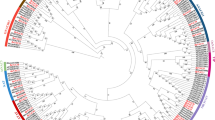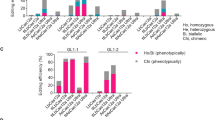Summary
Analysis of the transcription pattern of theBz2 locus revealed that overlapping transcripts are derived from opposite DNA strands. The most abundant transcript (sense transcript) has an open reading frame coding for a protein of 241 amino acids, whilst in the antisense orientation no open reading frame has been detected; the antisense transcripts are detected only in those tissues that show high levels of sense transcript. Particle gun experiments indicate that the sense transcript is sufficient to provide theBz2 function. The promoter driving the sense transcript contains the elements usually found in front of eukaryotic genes. In addition an element with similarity to theC1 andR binding sites identified in theBz1 promoter is found. Further upstream in the promoter region a transposon-like insertion has been identified. This element has features similar to members of theAc/Ds transposable element family. The putativeBz2 protein shows similarity to various other plant proteins and to anEscherichia coli protein. All related proteins have in common the fact that they are involved in stress responses.
Similar content being viewed by others
References
Adelman JP, Bond CT, Douglass J, Herbert E (1987) Two mammalian genes transcribed from opposite strands of the same DNA locus. Science 235:1514–1517
Bhattacharyya MK, Smith AM, Ellis THN, Hedley C, Martin C (1990) The wrinkled-seed character of pea described by Mendel is caused by a transposon-like insertion in a gene encoding starch-branching enzyme. Cell 60:115–122
Brown JWS, Feix G, Frendewey D (1986) A catalogue of splice junction and putative branch point sequences from plant introns. Nucleic Acids Res 14:9549–9559
Chomczynski P, Sacchi N (1987) Single-step method of RNA isolation by acid guanidinium thiocyanate-phenol-chloroform extraction. Anal Biochem 162:156–159
Cone KC, Burr FA, Burr B (1986) Molecular analysis of the maize anthocyanin regulatory locus C1. Proc Natl Acad Sci USA 83:9631–9635
Czarnecka E, Nagao RT, Key JE, Gurley WB (1988) Characterization of Gmhsp26-A, a stress gene encoding a divergent heat shock protein of soybean: heavy-metal-induced inhibition of intron processing. Mol Cell Biol 8:1113–1122
Devereux J, Haeberli P, Smithies O (1984) A comprehensive set of sequence analysis programs for the VAX. Nucleic Acids Res 12:387–395
Dooner HK, Nelson OE (1977) Genetic control of UDP-glucose: flavonol 3-O-glucosyltransferase in endosperm of maize. Biochem Genet 15:509–515
Gerats AGM, Huits H, Vrijlandt E, Marafia C, Souer E, Beld M (1990) Molecular characterization of a nonautomous transposable element (dTphl) ofPetunia. The Plant Cell 2:1121–1128
Goff SA, Klein TM, Roth BA, Fromm ME, Cone KC, Radicella JP, Chandler VL (1990) Transactivation of anthocyanin biosynthetic genes following transfer of B regulatory genes into maize tissues. EMBO J 9:2517–2522
Gronwald JW (1989) Influence of herbicide safeners on herbicide metabolism. In: Hatzios KK, Hoagland RE (eds) Crop safeners for herbicides. Academic Press, San Diego, California, pp 103–128
Grove G, Zarlengo RP, Timmermann KP, Li N, Tam MF, Tu CPD (1988) Characterization and heterospecific expression of cDNA clones of genes in the maize GSH S-transferase multigene family. Nucleic Acids Res 16:425–438
Harborne JB, Self R (1987) Malonylated cyanidin 3-glucosides inZea mays and other grasses. Phytochemistry 26:2417–2418
Hermann A, Schulz W, Hahlbrock K (1988) Two alleles of the single-copy chalcone synthase gene in parsley differ by a transposon-like element. Mol Gen Genet 212:93–98
Hopp W, Seitz HU (1987) The uptake of acylated anthocyanin into isolated vacuoles from a suspension culture ofDaucus carota. Planta 170:74–85
Klein TM, Wolf ED, Wu R, Sanford JC (1987) High velocity microprojectiles for delivering nucleic acids into living cells. Nature 327:70–73
Klein TM, Gradziel T, Fromm ME, Sanford JC (1988) Factors influencing gene delivery intoZea mays cells by high-velocity microprojectiles. Biotechnology 6:559–563
Köster-Töpfer M, Frommer WB, Rocha-Sosa M, Willmitzer L (1990) Presence of a transposon-like element in the promoter region of an inactive patatin gene inSolanum tuberosum L. Plant Mol Biol 14:239–247
Kunze R, Stochaj U, Laufs J, Starlinger P (1987) Transcription of transposable elementActivator (Ac) ofZea mays L. EMBO J 6:1555–1563
Larson R, Coe EH Jr (1977) Gene-dependent flavonoid glucosyltransferase in maize. Biochem Genet 15:153–156
Maas C, Laufs J, Grant S, Korlhage C, Werr W (1991) The combination of a novel stimulatory element in the first exon of the maizeShrunken-1 gene with the following intron 1 enhances reporter gene expression up to 1000-fold. Plant Mol Biol 16:199–207
McLaughlin M, Walbot V (1987) Cloning of a mutablebz2 allele of maize by transposon tagging and differential hybridization. Genetics 117:771–776
Menssen A, Höhmann S, Martin W, Schnable PS, Peterson PA, Saedler H, Gierl A (1990) The En/Spur transposable element ofZea mays contains splice sites at the termini generating a novel intron from a dSpm element in the A2 gene. EMBO J 9:3051–3057
Müller-Neumann M, Yoder JI, Starlinger P (1984) The DNA sequence of the transposable elementAc ofZea mays L. Mol Gen Genet 198:19–24
Nash J, Luehrsen KR, Walbot V (1990)Bronze-2 gene of maize: Reconstruction of a wild-type allele and analysis of transcription and splicing. Plant Cell 2:1039–1049
Neuffer MG, Jones L, Zuber MS (1968) The mutants of maize. Crop Science Society of America, Madison, USA
Nevers P, Shepherd N, Saedler H (1985) Plant transposable elements. Adv Bot Res 12:102–203
Nuffer MG (1953) A new pale aleurone gene. Maize Genet Coop News Lett 27:68
Nuffer MG (1954) Activator of bz2-m mutability. Maize Genet Coop News Lett 28:63
Nuffer MG (1955) Similarity of M and Ac mutator systems. Maize Genet Coop News Lett 29:59
Nuffer MG (1957) Allelism and mutability of anther-ear 6923. Maize Genet Coop News Lett 31:140–141
Nuffer MG, Coe EH (1956) A possible homozygous viable deficiency in the long arm of chromosome 1. Maize Genet Coop News Lett 30:101
Pearson WR, Lipman DJ (1988) Improved tools for biological sequence comparison. Proc Natl Acad Sci USA 85:2444–2448
Reddy GM, Coe EH Jr (1962) Inter-tissue complementation: A simple technique for direct analysis of gene action sequence. Science 138:149–150
Sambrook J, Fritsch EF, Maniatis T (1989) Molecular cloning: A laboratory manual. Cold Spring Harbour Laboratory, Cold Spring Harbour, New York
Sanger F, Nicklen S, Coulson AR (1977) DNA sequencing with chain-terminating inhibitors. Proc Natl Acad Sci USA 74:5463–5467
Schwarz-Sommer Zs, Gierl A, Cuypers H, Peterson PA, Saedler H (1985) Plant transposable elements generate the DNA sequence diversity needed in evolution. EMBO J 4:591–597
Serizawa H, Ryuji F (1987) Structure of the gene for the stringent starvation protein ofEscherichia coli. Nucleic Acids Res 15:1153–1163
Simons RW, Kleckner N (1988) Biological regulation by antisense RNA in prokaryotes. Annu Rev Genet 22:567–600
Sommer H, Carpenter RM, Harrison BJ, Saedler H (1985) The transposable element Tam3 ofAntirrhinum majus generates a novel type of sequence alteration upon excision. Mol Gen Genet 190:225–231
Spencer CA, Gietz RD, Hodgetts RB (1986) Overlapping transcription units in the dopa carboxylase region ofDrosophila. Nature 322:279–281
Styles ED, Ceska O (1989) Pericarp flavonoids in genetic strains ofZea mays. Maydica 34:227–237]
Sutton WD, Gerlach WL, Schwartz D, Peacock WJ (1984) Molecular analysis ofDs controlling element mutations at theAdhl locus of maize. Science 223:1265–1268
Takahashi Y, Kuroda H, Tanaka T, Machida Y, Takebe I (1989) Isolation of an auxin-regulated gene cDNA expressed during the transiton from G0 to S phase in tobacco mesophyll protoplasts. Proc Natl Acad Sci USA 86:9279–9283
Taylor JL, Fritzemeier KH, Häuser I, Kombrink E, Rohwer F, Schröder M, Strittmatter G, Hahlbrock K (1990) Structural analysis and activation by fungal infection of a gene encoding a pathogenesis-related protein in potato. Mol Plant-Microbe Interact 1:157–160
Theres N, Scheele T, Starlinger P (1987) Cloning of theBz2 locus ofZea mays using the transposable elementDs as a gene tag. Mol Gen Genet 209:193–197
Thompson-Jäger S, Domdey H (1990) The intron of the yeast actin gene contains the promoter for an antisense RNA. Curr Genet 17:269–273
van der Krol AR, Mur LA, Beld M, Mol JNM, Stuitje AR (1990) Flavonoid genes inPetunia: Addition of a limited number of gene copies may lead to a suppression of gene expression. Plant Cell 2:291–299
van der Zaal EJ, Droog FNJ, Boot CJM, Hensgens LAM, Hoge JHC, Schilperoort RA, Libbenga KR (1991) Promoters of auxin-induced genes from tobacco can lead to auxin-inducible and root tip-specific expression. Plant Mol Biol 16:983–998
Author information
Authors and Affiliations
Additional information
Communicated by H. Saedler
Rights and permissions
About this article
Cite this article
Schmitz, G., Theres, K. Structural and functional analysis of theBz2 locus ofZea mays: characterization of overlapping transcripts. Molec. Gen. Genet. 233, 269–277 (1992). https://doi.org/10.1007/BF00587588
Received:
Issue Date:
DOI: https://doi.org/10.1007/BF00587588




